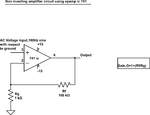shibas
Newbie level 6

I am posting the circuit diagrams of both the amplifiers:-
1.circuit of AD 620 instrumentation amplifier,designed for getting a gain of about 106.
2.circuit of non inverting amplifier using op amp ic 741,designed for getting a gain of about 101.
The gain equations of both the amplifiers are written inside a box near both the circuit diagrams iam attaching with this post.
I tried both the above amplifiers for amplifying the output of a vibration sensor or analyzer.
But when i gave the input from the function generator both the circuits amplified well.
For the non inverting amplifier using 741 ic,when i gave the input from the function generator at first i was getting a gain of about 50 and 68 when the input signal frequency was about 9.7 KHz.When i changed the input signal frequency to about 1 KHz i got the gain of about 100.But the original gain designed for this amplifier circuit was 101.When i gave the sensor output signal to the input of the non inverting amplifier it gave a gain of about 450.
When i used AD620 amplifier circuit,I get a gain value of about 100 when i was giving input signal from the function generator.When i gave the output signal from the vibration sensor as the input to the AD620 amplifier it also gave about a gain of about 450.
Why is the gain becoming very high when i give the sensor output as the input to the amplifier?
Which amplifier should i use for my need(for amplifying the sensor output)?
Should i make any modifications to my circuit.If then please suggest those modifications clearly.
Somebody please help me and reply fast.
1.circuit of AD 620 instrumentation amplifier,designed for getting a gain of about 106.
2.circuit of non inverting amplifier using op amp ic 741,designed for getting a gain of about 101.
The gain equations of both the amplifiers are written inside a box near both the circuit diagrams iam attaching with this post.
I tried both the above amplifiers for amplifying the output of a vibration sensor or analyzer.
But when i gave the input from the function generator both the circuits amplified well.
For the non inverting amplifier using 741 ic,when i gave the input from the function generator at first i was getting a gain of about 50 and 68 when the input signal frequency was about 9.7 KHz.When i changed the input signal frequency to about 1 KHz i got the gain of about 100.But the original gain designed for this amplifier circuit was 101.When i gave the sensor output signal to the input of the non inverting amplifier it gave a gain of about 450.
When i used AD620 amplifier circuit,I get a gain value of about 100 when i was giving input signal from the function generator.When i gave the output signal from the vibration sensor as the input to the AD620 amplifier it also gave about a gain of about 450.
Why is the gain becoming very high when i give the sensor output as the input to the amplifier?
Which amplifier should i use for my need(for amplifying the sensor output)?
Should i make any modifications to my circuit.If then please suggest those modifications clearly.
Somebody please help me and reply fast.


